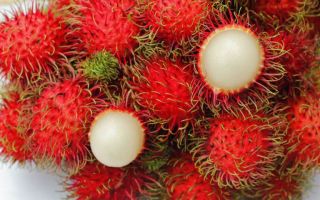Content
The rambutan fruit is an exotic product, which, nevertheless, is quite often found in Russian stores. It is interesting to study the properties of the product and figure out how to eat it correctly in order to get the maximum pleasure and benefit from the fruit.
What rambutan looks like
The fruit has such an unusual appearance that it is very difficult to confuse it with any other. In size, oval fruits reach about 6 cm, their peel is not thick, but dense, light or dark red in color. The rind is densely covered with long soft thorns, which makes the fruit look like hairy, although the thorns are rather rough to the touch.
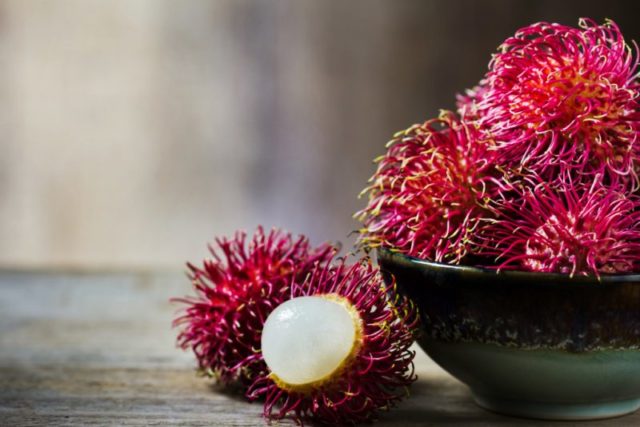
Under the peel of the rambutan, there is a flesh that is eaten. It is very juicy and tender, creamy in color, jelly-like in consistency. In the center of the fruit is an oval brown seed.
How and where does rambutan grow
An exotic fruit grows on the evergreen tree of the same name. In height, it can reach 25 m, its crown is spreading, with small oblong green leaves. Rambutan blooms with panicle inflorescences, the fruits are also collected in clusters of up to 30 pieces in each brush. At first, the fruits have a green color, and only as they ripen do they acquire a rich red color, it is in this form that they are eaten.
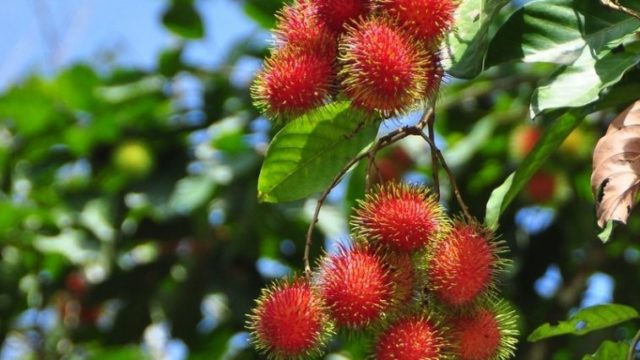
Under natural conditions, the fruit grows in Thailand, Southeast Asia, Sri Lanka, Indonesia, in countries where high temperatures are always maintained. In cold regions and the middle lane, the fruit is not cultivated.
What does rambutan taste like
According to gourmets who eat the fruit more or less often, the taste of rambutan is similar to the dessert grapes "ladies' fingers". Depending on the variety and degree of ripeness, rambutan can be predominantly sweet or slightly sour, but in any case, it is eaten with pleasure, since the taste is very refreshing.
Difference between rambutan and lychee
Both lychee and rambutan belong to the category of exotic foods in the absence of experience they can be confused.
There is a certain similarity between the fruits, but they also differ quite strongly:
- Rambutan in size usually does not exceed a walnut, its peel is dense and bright red, covered with long soft hairy thorns. The eaten pulp is whitish-transparent in the fruit, sweet with a slight sourness.
- Lychee slightly smaller in size than rambutan. Ripe fruits are also covered with a dark pink or red dense peel, however, the thorns on it are very short, slightly protruding above the surface. The fruits do not look "hairy" at all, and this is the main difference from rambutan.

The flesh of both fruits is similar, however, in lychee it is milky white, and in rambutan it is slightly transparent. Those who eat both fruits claim that they taste like sweet grapes.
Composition and calorie content of rambutan
According to its composition, the product contains mainly carbohydrates in its pulp - about 19 g of the total volume. There are few proteins and fats in fruits - 0.6 and 0.2 g, respectively.
The pulp of an exotic fruit contains a large amount of valuable substances. Namely:
- subgroup B vitamins - from B1 to B9, approximately 1-2% of the daily requirement;
- vitamin C - more than 5% of the daily value;
- vitamin PP - over 6% of the daily dosage;
- manganese, from fruits you can get 17% of the daily value of this element;
- copper - about 6% of the daily dosage.
Rambutan fruits also contain iron and potassium, calcium and magnesium, phosphorus and sodium, zinc, all these substances are present in the pulp in small amounts. Fruits contain organic acids and amino acids, fiber and ash.
The calorie content of the product is average - about 82 kcal per 100 g of product. The fruit does not lead to weight gain if eaten in small quantities.
How to eat rambutan correctly
When you first meet an exotic fruit, it is not entirely clear how it is eaten. But it is very simple to prepare a product for use, it does not require long preliminary processing.
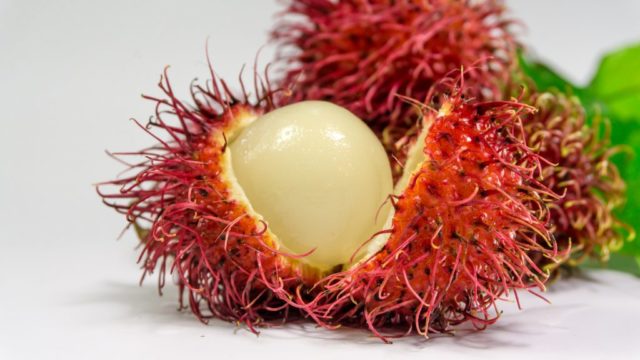
How to choose rambutan
In order for the fruit to be beneficial, first of all, it must be chosen correctly. Ripe rambutan should be deep red or red-orange, bright. It is important that the peel is intact and healthy, free from dots, blemishes, scuffs and dents.
The same applies to the hairy spines. Although not eaten, a quality rambutan should have them whole, straight, and intact.
How to peel rambutan
Despite the unusual appearance of the fruit, peeling rambutan is not much more difficult than peeling an orange:
- With a sharp knife, the fruit is carefully cut along the peel along the entire circumference, approximately in the middle. It is not necessary to press hard on the knife, since the peel of the fruit is thin.
- Rambutan is held by fingers for one of the halves, and the second is simply pulled by the peel, and the incised part is removed from the pulp, like a cap, without effort.
After that, you can lightly press on the remaining half of the peel so that the ripe pulp pops out of it onto the plate. You can also leave the bottom half of the rind in place and serve the rambutans half-peeled so that everyone can decide for themselves how to eat the fruit.
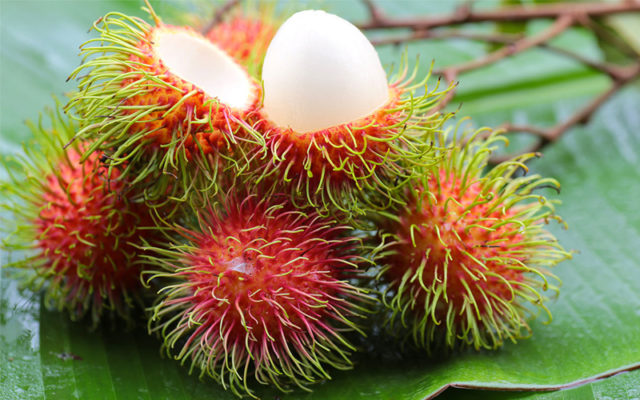
How to eat rambutan
Fully or half-peeled rambutan is eaten in two ways:
- The easiest way is to use a sharp knife, cut the peeled fruit and remove the bone from the center to leave only the white pulp, after which it is eaten as convenient.
- You can simply bite off the pulp without using a knife, but this method is rarely eaten. This is less convenient, since the pulp of the fruit is elastic and with fibers, and it is rather difficult to separate pieces from it with your teeth. In addition, there is a great risk of accidentally touching a bitter bone, and they do not eat it when eating fruits.
Sometimes completely peeled rambutan is eaten after removing the bone, cutting the pulp into small pieces and serving on the table on a plate. Preparing the fruit in this case will take more time, but it will be easier to eat it.
Can you eat rambutan bones
The raw seeds hidden in the center of the fruit are not only bitter in taste but also poisonous. They are never eaten unprocessed and can lead to serious poisoning.
Rambutan storage rules
The beneficial properties of a tropical fruit does not last long.You can keep it in the refrigerator for about 10 days, provided that the fruits are wrapped in a paper towel and do not come into contact with each other and other products. It can stay fresh for 3-5 days at room temperature, but it is usually eaten after being stored in the refrigerator.
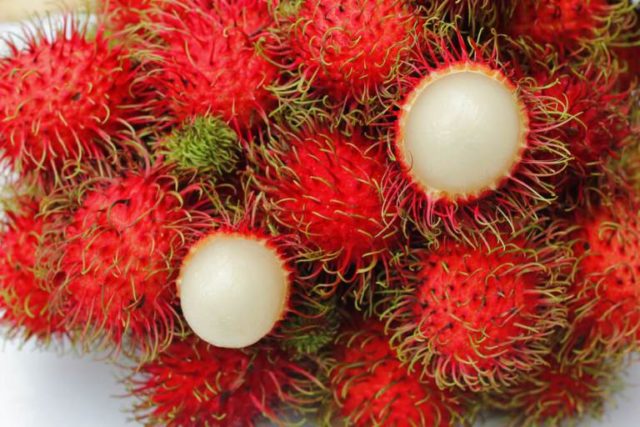
Useful properties of the rambutan fruit
An exotic fruit has many health benefits. If eaten competently and in moderation, then he:
- has anti-inflammatory and antibacterial effects;
- helps with diarrhea and dysentery, and also helps to get rid of worms;
- improves the condition of blood vessels and lowers pressure in hypertension;
- accelerates metabolism and normalizes digestion and bowel emptying;
- promotes weight loss;
- improves the condition in atherosclerosis and protects the heart from ailments;
- helps with viral and colds;
- has a rejuvenating effect and promotes cell renewal;
- strengthens the immune system;
- helps with neurological disorders and insomnia.
Rambutan is eaten for hair and skin care. Trace elements and vitamins in the composition of the fruit strengthen the curls, and make the skin more silky and elastic. Rambutan is not prohibited during pregnancy, women eat it to combat constipation and edema, if there is no allergy.
Useful properties of rambutan peel
The peel is not eaten raw, but it is not necessary to throw it away. The skin also contains useful substances, in particular, valuable gallic acid. This component is responsible for the elimination of toxins from the body and prevents the proliferation of free radicals. Therefore, in folk medicine, there are recipes for infusions and decoctions based on the peel, such drinks have cleansing and anti-cancer beneficial properties.
Attention! Raw rambutan peel is toxic - tannins and saponins in its composition can lead to poisoning. It is possible to use the properties of the skin for medicinal purposes only after heat treatment.
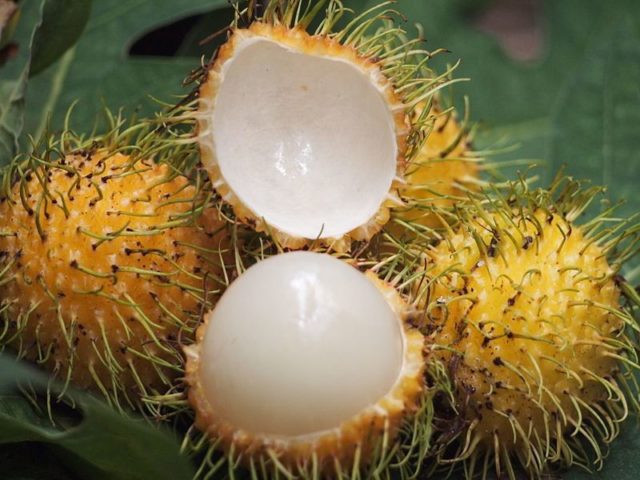
Why is rambutan useful for the human body?
Among the features of the product, several strong positive properties can be distinguished. The fruit is eaten for beneficial effects on the immune system, strengthening the heart system, and also to protect against very serious ailments.
For the immune system
Rambutan contains a lot of ascorbic acid and other vitamins. In addition, the fruit pulp contains protein and healthy carbohydrates. Therefore, the product is eaten to strengthen the immune system and to increase overall endurance.
It is introduced into the diet for the prevention and treatment of colds, as well as during the recovery period after illness. The properties of the fruit replenish the reserves of energy and vitamins and restore vitality.
For the heart and blood vessels
The fruit contains many antioxidants and substances that improve blood composition and regulate blood viscosity. With moderate use, rambutan lowers cholesterol and makes the walls of blood vessels strong and elastic, and prevents the development of ischemia. With health benefits, exotic fruits are eaten by hypertensive patients and the elderly, especially those prone to cardiovascular ailments.
For digestion
In the absence of serious pathologies of the digestive system, the properties of the product are of great benefit to the stomach and intestines. The anti-inflammatory properties of the fruit help prevent irritation of the mucous membranes, protect against the formation of erosions and ulcers.
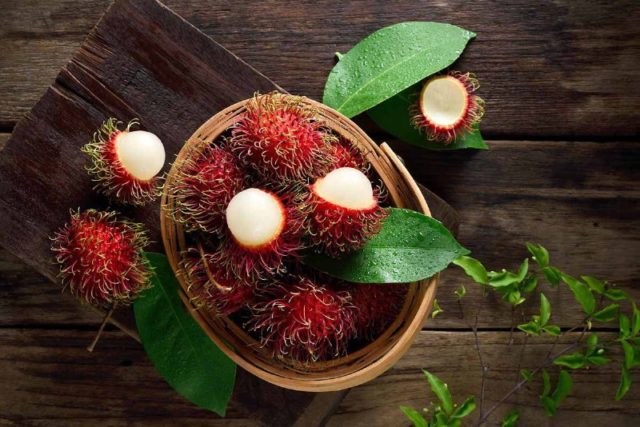
Rambutan speeds up digestion, so it is eaten to prevent constipation and remove toxins and toxins from tissues.Regular consumption of healthy fruit helps protect against cancer, in particular, against cancers in the stomach and colon.
With diabetes
Fresh healthy fruits have a low glycemic index - about 40 units. With moderate consumption of fruit, the blood glucose level decreases, concomitant diseases develop less often against the background of diabetes mellitus. The beneficial properties of the fruit have a beneficial effect on the pancreas and improve its work, which is especially important in this disease.
With oncology
The beneficial antioxidant properties of rambutan pulp make it an additional cancer-fighting agent. The fruit slows down the development of malignant cells and prevents the spread of metastases, increases the body's immune forces and helps fight serious illness. Heat-treated rambutan peel also has good anti-cancer properties.
It must be remembered that the product for cancer is eaten only against the background of official drug therapy. Fruit is not a complete medicine, it cannot serve as the only remedy.
For acne
The anti-inflammatory substances in the product make it a useful natural remedy for acne. For people who regularly eat rambutan, the skin on the face and body is cleansed, hydrated and smoother. You can also use the product for acne externally - when the pulp is applied to the skin, the beneficial effect comes even faster.
The beneficial properties of rambutan help not only with acne and acne, but also with any other inflammatory skin processes. The fruit is eaten and used externally to help heal cuts, burns, and irritations as quickly as possible.
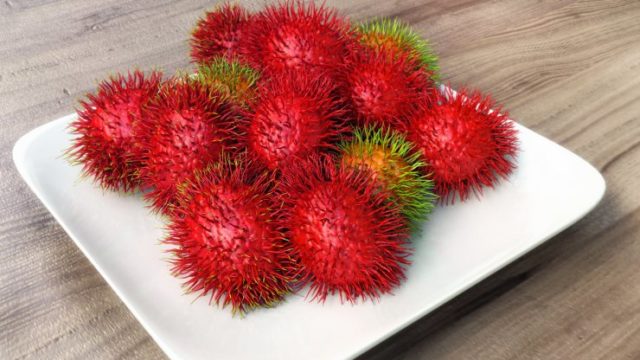
Using rambutan
The benefits of rambutan are used in several areas. In addition to food consumption, the fruit is used in recipes for health improvement and in cosmetic masks.
In folk medicine
Rambutan occupies an important place in the traditional medicine of Thailand and Malaysia. With the help of the beneficial properties of the pulp, peel and seeds of an exotic fruit, they treat dysentery and vascular diseases, digestive ailments and colds, fever and headache.
The following product-based product is popular:
- the peel of several fruits is crushed and poured with 500 ml of hot water;
- on moderate heat, the raw materials are boiled until the liquid boils off by half;
- after that, the broth is removed from the stove, filtered through cheesecloth and topped up with clean water to the initial volume.
You need to take the remedy twice a day, 250 ml, the properties of the broth help well with dysentery and diarrhea, and also relieve headaches and reduce fever. Young mothers can use it for lactation, it improves the production of breast milk.
A decoction of rambutan can be used to rinse your mouth and throat in case of inflammatory diseases. For joint ailments, lotions and compresses are made for the sore spot using a medicinal infusion.
With constipation, the use of fruit pulp helps well. Its useful properties are used as follows - they eat several fresh fruits shortly before the main meal, this is enough for metabolic processes to normalize.
In dietetics
Vitamin tropical fruit is recommended for weight loss diets. Rambutan contains a lot of fiber and also has diuretic properties, so it is eaten to cleanse the body of excess fluids and toxins.
Against the background of eating fruit, metabolism accelerates, the body assimilates nutrients better and stores less fat. Those who eat the fruits note that they dull the feeling of hunger, so the diet is easier and more pleasant to tolerate.

In cosmetology
The tropical fruit is widely used in cosmetology. On the basis of peel and seed oil extracts, aromatic soaps, as well as creams, masks and tonics for the face are produced. Rambutan oil can be found in shampoos and deodorants, shower gels, and body lotions.
Home cosmetology also offers recipes using rambutan. For example, such a nourishing face mask has good properties:
- pulp of 2 fruits is kneaded into gruel;
- 1 small spoonful of cottage cheese and egg white are added to rambutan;
- the product is mixed and distributed over the skin for 15 minutes.
With regular use, a beneficial mask can help relieve dry skin and the first symptoms of wilting.
Another good mask to cleanse your skin:
- the pulp of two rambutans is crushed to a pulp state;
- add 1 small spoonful of fresh orange juice;
- bring in half a small spoonful of kefir and ground coffee.
The mixture is stirred and applied for 15 minutes on the face, before removing, gently massage the skin. A mask with a scrubbing effect will eliminate dead cells of the epidermis and renew the skin, while rambutan and other components nourish the skin with useful substances.
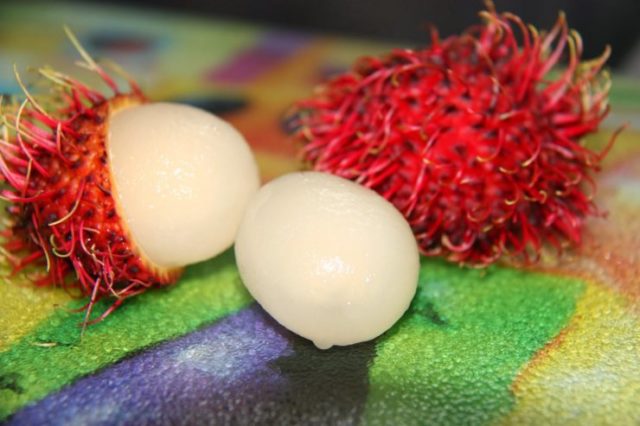
In cooking
Basically, rambutan is eaten as a light fruit snack and consumed as a separate dessert. But if desired, the fruits can be mixed with other products:
- Rambutan goes well with fruit salads and natural yoghurts, fruit pieces are eaten as part of sweet pastries and ice cream.
- Rambutan is canned with sugar for long storage, and jams, compotes and preserves made from its pulp are also eaten.
- The fruit is added to non-alcoholic cocktails and spirits to give drinks an unusual taste and aroma.
Sometimes rambutan is eaten with seafood, fish and poultry, it gives the listed products a spicy sweet taste.
Limitations and contraindications
The main contraindication to the use of rambutan is food allergy. Other restrictions include:
- gastritis and stomach ulcers in a state of exacerbation;
- acute pancreatitis;
- intestinal colitis.
Fruits are eaten with caution if they are prone to diarrhea, the properties of rambutan in this case can cause indigestion.
Conclusion
Rambutan fruit is a healthy and tasty tropical product with a very unusual appearance. If you are not allergic to the fruit, then when consumed, it will bring continuous health benefits and insure against some serious ailments.

